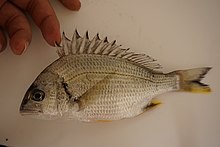Acanthopagrus latus
| Acanthopagrus latus | |
|---|---|

| |
| Scientific classification | |
| Domain: | Eukaryota |
| Kingdom: | Animalia |
| Phylum: | Chordata |
| Class: | Actinopterygii |
| Order: | Spariformes |
| Family: | Sparidae |
| Genus: | Acanthopagrus |
| Species: | A. latus
|
| Binomial name | |
| Acanthopagrus latus (Houttuyn, 1782)
| |
| Synonyms[2] | |
| |
Acanthopagrus latus, the yellowfin seabream, grey bream, Houttuyn's yellowfin seabream, Japanese bream or yellow-finned black porgy, is a species of marine
, the seabreams and porgies. This fish is found in the Western Pacific Ocean.Taxonomy
Acanthopagrus latus was first formally
Etymology
Acanthopagrus latus has the
Description
Acanthopagrus latus has 10 spines and 10 or 11 soft rays supporting the
Distribution and habitat
Acanthopagrus latus occurs in the east Asian shelf area of the Western Pacific Ocean from
Biology
Acanthopagrus latus feeds in small groups on tidal flats, mainly on benthic invertebrates such as echinoderms, molluscs, worms and crustaceans. At least some individuals are
Fisheries and aquaculture
Acanthopagrus latus is largely caught by artisanal fisheries and the fish landed are sold fresh in markets. It is also used in traditional Chinese medicine. This species has been the subject of attempts at artificial spawning in Taiwan. The larvae and juveniles have also been collected from estuaries to be used to restock habitats and for their aquaculture potential.[1]
References
- ^ . Retrieved 21 December 2023.
- ^ a b c d e Froese, Rainer; Pauly, Daniel (eds.) (2023). "Acanthopagrus latus" in FishBase. October 2023 version.
- ^ Eschmeyer, William N.; Fricke, Ron & van der Laan, Richard (eds.). "Species in the genus Acanthopagrus". Catalog of Fishes. California Academy of Sciences. Retrieved 21 December 2023.
- .
- ^ Parenti, P. (2019). "An annotated checklist of the fishes of the family Sparidae". FishTaxa. 4 (2): 47–98.
- OL 25909650M.
- ^ "Order SPARIFORMES: Families LETHRINIDAE, NEMIPTERIDAE and SPARIDAE". The ETYFish Project Fish Name Etymology Database. Christopher Scharpf. 17 October 2022. Retrieved 21 December 2023.
- ^ K.E. Carpenter (2001). "Sparidae". In Carpenter, K.E. and Niem, V.H. (eds.). FAO species identification guide for fishery purposes. The living marine resources of the Western Central Pacific. Volume 5. Bony fishes part 3 (Menidae to Pomacentridae) (PDF). FAO Rome. p. 2990.

